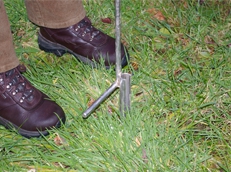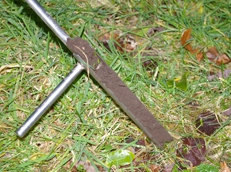A soil analysis is the best way to check that your grass has everything it needs in order to grow and thrive. Such an analysis identifies the quantities of nutrients which are present in the soil and are available to be used by the plants. The analysis also identifies what additional nutrients need to be added in order to promote excellent growing conditions.
We have two standard types of soil analysis:
- Basic soil analysis – which tests the pH balance of the soil (i.e. the acid or alkaline content), as well as phosphate, potash and magnesium levels.
- Animal health analysis – which tests for all of the above levels, as well as sulphur, sodium, manganese, copper, iron, zinc, molybdenum, boron, cobalt, iodine and cation exchange capacity.
We can also test for many other nutrient levels, so if you have a particular problem let us know and we can carry out specific tests to then look at ways to address it.
When taking a soil analysis, we come to your fields and take a range of samples from different areas of the paddock. This means we get an analysis of the whole field, rather than just one area, which may not be a true representation of the whole field.
The samples are then sent to a laboratory for analysis.
 We then send you the results together with recommendations on the type and quantities of nutrients which should be applied to the fields, and when. We will also include further suggestions on how you could improve your fields by carrying out different maintenance procedures during the year, such as chain harrowing or topping.
We then send you the results together with recommendations on the type and quantities of nutrients which should be applied to the fields, and when. We will also include further suggestions on how you could improve your fields by carrying out different maintenance procedures during the year, such as chain harrowing or topping.
Depending on the results of the analysis, it may well be that your paddocks do not require additional nutrients. This will save you money on buying unnecessary fertilisers, and you’ll also be doing your bit for the environment by reducing excessive fertiliser use.
 Grass requires a pH level of 6- 6.5, i.e. it should be neutral. At this pH level other nutrients found in the soil are most available for the plant. If your soil analysis results are less than this figure, your land is too acidic and will need applications of a calcium rich nutrient such as crushed limestone. In our experience a lot of horse paddocks, which haven’t been treated, are high in acidity. Acidic land provides the growing conditions preferred by bracken, gorse and moss to grow. Where land has a high alkaline content it often has a high calcium or sodium content. In such cases a sulphur rich nutrient could be added.
Grass requires a pH level of 6- 6.5, i.e. it should be neutral. At this pH level other nutrients found in the soil are most available for the plant. If your soil analysis results are less than this figure, your land is too acidic and will need applications of a calcium rich nutrient such as crushed limestone. In our experience a lot of horse paddocks, which haven’t been treated, are high in acidity. Acidic land provides the growing conditions preferred by bracken, gorse and moss to grow. Where land has a high alkaline content it often has a high calcium or sodium content. In such cases a sulphur rich nutrient could be added.
However, it is important to only add the correct amount of nutrients to your land on a ‘little and often’ basis, to ensure you provide the right conditions for the grass to grow. The aim is to replace the amounts of nutrients which are being taken away as a result of grazing or cutting and removal.
For most people the soil analysis is the first step in improving their pasture. At Posh Paddocks we can offer you the full service from taking the samples, to applying the correct amount of required nutrients on the fields.


